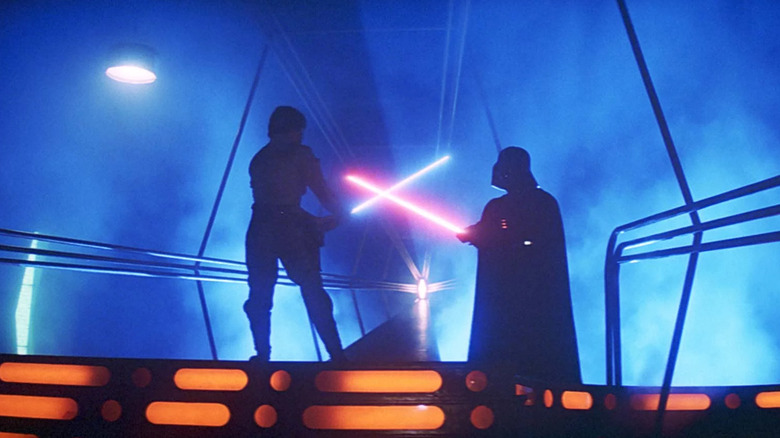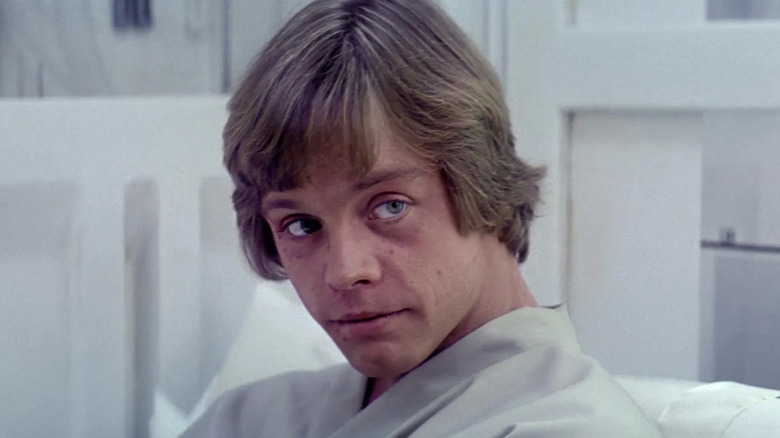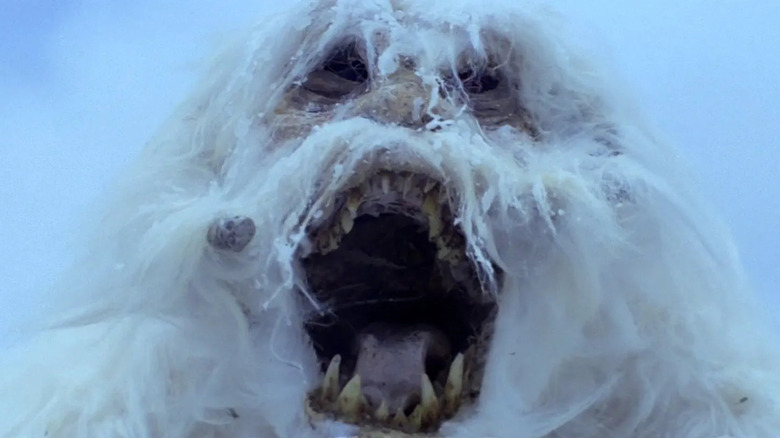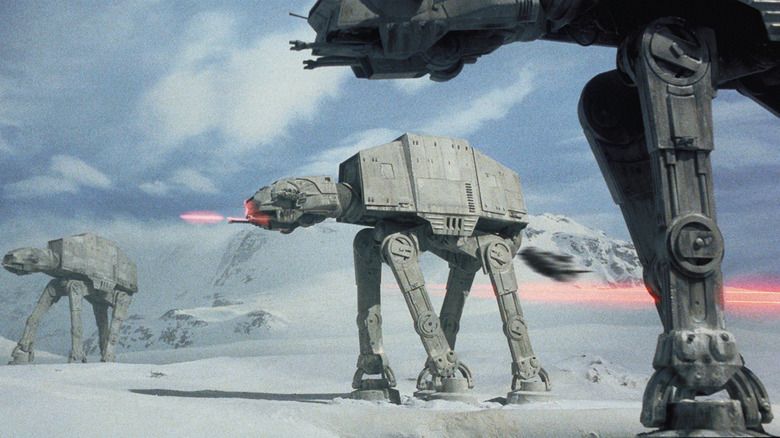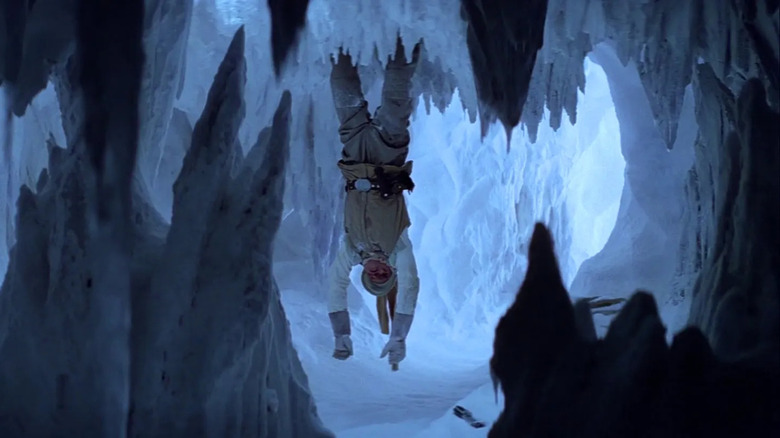Was The Empire Strikes Back Changed Due To Mark Hamill's Car Accident?
After the swashbuckling, escapist "A New Hope," we're in a far darker place in "The Empire Strikes Back." From our first glimpse of the icy wastes of Hoth, we know we're in for a far more somber adventure this time around.
The franchise's transition from Boys' Own Space Adventure to Shakespearean family saga is well-served by the visual contrasts in the opening act of each film. Where a large part of the first movie was set in the deserts of Tatooine, basking in the bright light of the planet's twin suns, we are in an even more hostile environment now. Buoyed by the success of "A New Hope," this is where "Star Wars" creator George Lucas had the confidence to expanded his themes significantly, adding layers of destiny and tragedy that make "The Empire Strikes Back" the best film of the nine-episode Skywalker Saga.
The Tatooine scenes were shot in the desert of Tunisia, which had its own challenges. That was nothing compared to the hardships endured by cast and crew when they filmed the Hoth scenes in the brutal cold of a Norwegian winter, where temperatures plunged to almost minus 40 degrees celsius. Some crew members reportedly suffered frostbite and Harrison Ford completed the last leg of his journey to set by snowplough. This unforgiving environment is essential to the bleak, wintry tone of the film.
"The Empire Strikes Back" came only three years after the runaway success of "A New Hope," but our central figures all look significantly different. Part of this is because the story finds them during a dangerous time; the first flush of victory has worn off and they are feeling the very real consequences of destroying the Death Star and the merciless backlash from the Empire. Princess Leia (Carrie Fisher) now looks more worldly as she settles into her leadership role within the Alliance, while Han Solo is far more grave and less flippant now he has a bounty on his head from Jabba the Hutt.
No-one looks more different that Luke Skywalker (Mark Hamill), and the changes aren't just due to the requirements of the screenplay.
Mark Hamill's accident
On January 11, 1977, with just a few pick-up shots left to do before "A New Hope" was finished, Mark Hamill was in a car accident that left director George Lucas using doubles to complete the movie. Hamill later talked frankly about the incident (via Insider):
"What happened was that I was on the wrong freeway... I was way out in the sticks somewhere and there were no cars and no traffic, thank God. I was going about 65-70 mph... I was speeding, going too fast... and what happened, I think, was that I tried to negotiate an off-ramp and lost control, tumbled over, and went off the road. I fractured my nose and my cheek."
The accident and Hamill's injuries passed largely without comment from the media, because at that point he was the unknown lead in a sci-fi movie no one expected to be the global phenomenon it became on its release four months later. Hamill fractured his cheek and nose, which required reconstructive surgery using cartilage from his ear. When it was over, he looked noticeably different. He felt that his career was over almost before it had begun.
It wasn't the first time that an injury almost ended an up-and-coming actor's career. Back in 1919, rising silent comedy star Harold Lloyd lost a thumb and forefinger when he mistook a real bomb for a prop. Incredibly, he recovered enough to perform some of his most famous stunts with the disability, using a prosthetic glove to disguise his missing digits (via Vanity Fair). In 1970, a back injury sustained during training almost curtailed Bruce Lee's ascent to martial arts superstar, but he fought towards recovery and through chronic back pain to become a legend in "Fists of Fury" and "Enter the Dragon." (via Straight to the Bar).
The revelations about Hamill's accident have led the rumor mill to suggest that his altered physical appearance also had an impact on the beginning of "The Empire Strikes Back," especially regarding the Wampa attack.
So what's a Wampa attack again?
The members of the Rebel Alliance have their backs to the wall at the start of "The Empire Strikes Back." After successfully blowing up the Death Star, Imperial troops have been pursuing the Alliance across the galaxy. And they're led by Darth Vader, who is hellbent on tracking down Luke Skywalker. We open on the icy planet of Hoth, which isn't the coziest place to hole up, but hey, at least they're safe for the moment.
Han and Luke are out scouting the area when, seemingly out of nowhere, a large yeti-like beast called a Wampa attacks Skywalker, killing his Tauntaun steed and slashing his face. The creature drags the unconscious Luke to its lair, where he narrowly escapes by using the Force to grab his lightsaber at the last moment, severing the Wampa's arm and stumbling out into the barren wastes. Lost in a blizzard, Luke is on the verge of death, but then he receives a vision of his deceased mentor, Obi-Wan Kenobi (Alec Guinness), who tells him to seek out Yoda on the swamp planet Dagobah.
Just when it looks like curtains, Han Solo rides to the rescue and saves Luke by opening up his own Tauntaun, which had already died, and tucking his friend away inside its nice warm guts while he builds an igloo. Once they are picked up, Luke receives medical attention back at the base.
It never occurred to most audiences (and to me) that the Wampa attack was anything but part of the story, showing the dangers of Hoth's deadly environment. But once you know the whole story, it takes on a different context.
Was the Wampa attack scene included to explain Hamill's facial differences?
There is little doubt that the opening of "The Empire Strikes Back" would be more pacy without the Wampa attack scene, jumping straight into the Imperial assault on the base. Arguably, the Wampa could have been cut altogether without making much difference to the plot. True, we see that Luke's Force skills have improved a little, but the only key story point is Obi-Wan's visitation. That could have just as easily occurred while Luke was flying out to meet the AT-ATs, like it does in the final assault on the Death Star at the end of "A New Hope." It works better dramatically this way, though, with the message coming when Luke is on the verge of death, suggesting destiny isn't done with the fledgeling Jedi just yet.
If the legends are true, the scene may feel unnecessary because Lucas only included it to explain the difference in Luke's facial appearance. However, the plot thickens, as Lucas has flat-out denied this was the reason for the scene's existence (via Insider):
"But my feeling was some time had past, they've been in the Rebellion fighting, that kind of thing, so the change was justifiable. There's a scene in the film where Mark gets beat up by the monster [Wampa], which helps even more, but that wasn't really the meaning of why we wrote the monster in the beginning. We needed something to keep the film suspenseful at the beginning while the Empire is looking for them."
Lucas's reasoning sounds legit, and why would he lie about such a thing in the first place? It's like he's trying to cover up a scandal. But then someone else casts doubt on the story.
Carrie Fisher contradicts Lucas' story
Carrie Fisher remembers things differently from Lucas's version (via Insider):
"I was still shooting 'Star Wars' when Mark got into the car accident... It was a really bad accident. Miraculously his teeth didn't shatter. But his nose did. He had to have some of his ear put into his nose. So they adjusted the film with this snow monster to right away in the movie scratch his face to account for his looks being different."
There are images from a deleted scene floating around that shows Luke's face in bandages. Cutting this moment was probably a good idea, because it may have drawn attention to the possibility that Lucas and director Irvin Kershner were going to extra lengths to explain Hamill's new look.
Whatever the truth, these conflicting accounts add an extra layer of mythos to one of the most obsessively talked-about franchises in movie history. I'm really glad the Wampa scene exists for a few reasons. Firstly: I absolutely loved my Wampa and Tauntaun action figures when I was a kid, especially the slit in the Tauntaun's belly where you could tuck away your Luke figure.
But the Wampa scene also contributes to the ominous tone of "The Empire Strikes Back," adding to the sense that the odds are really stacked against the Rebels and they are cornered in a very inhospitable place. Our heroes really go through the wringer in this movie; C-3PO is pulled apart, Luke later loses a hand, and Han Solo ends up frozen in carbonite. It's the bleakest episode of the original trilogy by far, making the triumphant victory at the end of "Return of the Jedi" feel all the more joyous.
Beyond that, the Wampa and Tauntaun fit so nicely into the rich menagerie of weird and wonderful creatures that inhabit the "Star Wars" universe, which really helps us believe that we're in a faraway galaxy teeming with exotic life. Exotic life that can really, really hurt you.
